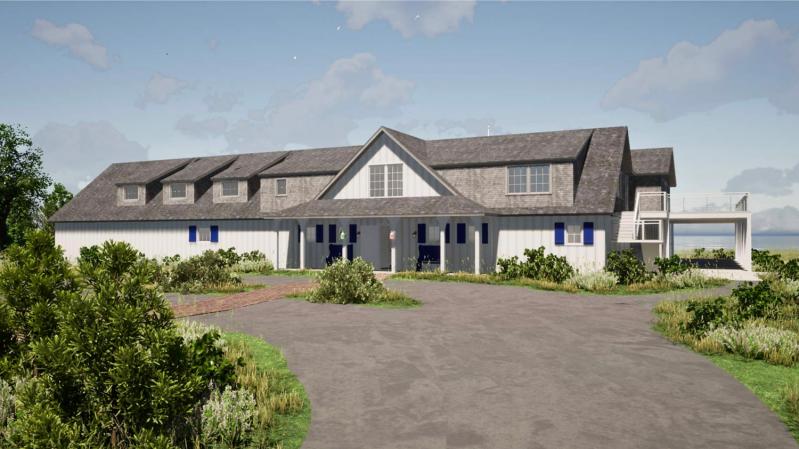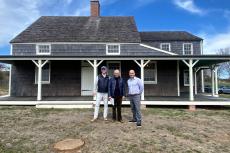There were a lot of numbers to digest when representatives of the private 400-member Devon Yacht Club presented plans to the East Hampton Town Planning Board last week for a complete redevelopment of the site at the end of Abram’s Landing Road in Amagansett.
The current structures, which are nonconforming, would be demolished and reconstructed, in many cases expanded, and sometimes relocated. It is a complex application, as evidenced by the book-size Planning Department memo that delves into all the nooks and crannies. Besides the planning board, the zoning board of appeals would need to grant a natural resources special permit, wetland setback variances, and others. The architectural review board will weigh in on the building designs, which Richard Warren of Inter-Science, a land-use planner speaking for the yacht club, said would be “within the natural traditional vernacular.”
“It’s something you would never be able to do if you didn’t already have it,” said Ian Calder-Piedmonte, a planning board member. “But what’s there right now is somewhat problematic, and I think what you’re trying to do is improve it. There are a ton of details.” Like other planning board members, he emphasized that “environmental concerns are paramount,” as the lot gets redeveloped.
A new 15,000-square-foot clubhouse is proposed for the 13.82-acre parcel tucked between Gardiner’s Bay and freshwater wetlands in a quiet residential neighborhood. The current clubhouse is 9,301 square feet. A public beach adjacent to the club guarantees that the project will have a visible impact. Not only would the buildings get second stories, but 5,467 cubic yards of fill (resulting in 274 truck trips) would be imported to the site to raise the land. “It’s a necessary evil for the sanitary,” said Mr. Warren. All that added height has led to concerns about massing. At present, all the buildings are single-story structures.
The proposed second stories would lead to a 46-percent bump in gross floor area, “a large increase” according to the memo. While the gross floor area would expand, the overall coverage on the lot would not, since the building footprints would change little.
“I don’t want that to become the boogeyman that scares everyone,” said Mr. Warren. The club was open to discussing a cap on the membership at 400, to assuage any concerns that the increase in building size would lead to an intensification of the land use. “This is costing the membership not an insignificant amount of money, with no increase in revenues, because they are not bringing in more members. There’s no interest or objective to increase the use or intensity of the club,” he said.
“It’s important to recognize there’s an increase in square footage, but it’s all upstairs and all really to improve the functionality of the club,” he said. Members would enjoy a new place to play cards, a room for the board of governors to meet, and space for casual dining. Because the club is in a Federal Emergency Management Agency flood zone, a basement could not be built to accommodate those functions.
A new 4,313-square-foot sailing center, 1,865-square-foot bath house, nearly 5,000-square-foot staff residence, which moves closer to the clubhouse away from wetlands, and an 849-square-foot workshop would be erected. The expansion of the sailing center was largely for equipment storage, said Mr. Warren, and to add a classroom where sailing could be taught to children in bad weather. The staff housing would accommodate 26 employees.
Many of the changes, while large, could result in positive outcomes. Moving the buildings landward and raising the grade of the entire property enhances the flood resiliency of the club, which sits in both a coastal erosion overlay district and a flood hazard overlay district. The septic system serving the current staff quarters is “cheek by jowl” with the freshwater wetland, said Michael Hansen, a board member, and moving and replacing it would be a benefit.
Construction would occur in two phases. Assuming approvals went through, the first phase would begin after Labor Day 2024. It would include demolition of the existing clubhouse, construction of a new one, and rebuilding of the sanitary system. Mr. Warren said those overseeing the project would keep a “tight leash” on the contractors doing the work because “they don’t want to lose a summer of operation for their membership.” The club would reopen for that summer’s season on July 4, and shut down again afterward for phase two. That phase, Mr. Warren explained to the Amagansett Citizens Advisory Committee on Monday night, calls for a 46-percent increase in the square footage of buildings, a much larger kitchen, handicapped-accessible bathrooms, creating “a larger dune in front of the clubhouse to resist erosion (“We moved it back as far as we could, between 10 and 40 feet, though the membership wants to retain the water view”), reconstructed tennis courts, accommodations for 26 employees, including a staff dining room, and a drainage system.
“We’d prefer not to put all this drainage in, but we have to meet the standards of the town,” Mr. Warren told the planning board. A robust landscaping plan that included native vegetation suitable for wetlands and dunes would be a big improvement on what’s existing, planners agreed.
A flagpole, proposed on top of a dune, generated more discussion than the 15,000-square-foot clubhouse. “If you’ve ever been to any yacht club, you know that flagpoles are very important,” said Mr. Warren. “When it’s dusk, and they drop the flag, everyone in the clubhouse, if they’re sitting down, they stand up. It’s a little bit of a ceremony.” He said it had to be far enough from the clubhouse to create a clear sightline.
The planning board seemed happy to leave the details of that discussion to the Z.B.A., which would ultimately decide on the variance.
Louis Cortese, a planning board member, said he understood the positives, but nonetheless, because nonconforming structures were being expanded, “It should be looked at with an extra magnifying glass.” He worried that the Planning Department was relying on numbers from the yacht club to figure if the expansion would lead to more than a 50-percent increase in the parcel’s value. If so, the yacht club would need a new special permit. “How do we ensure that the data they provide is correct and accurate?” he asked.
Mr. Cortese had more questions regarding sanitary flow numbers. The yacht club claims flow would increase from 4,771 to 5,439 gallons per day, but without an increase in use, he wondered why the numbers would rise. Devon said roughly 11,000 gallons of water were used per day. Mr. Cortese wanted to understand if the club was really using nearly 6,000 daily for irrigation. Even with moving the staff residence away from the wetlands, he found the setback to be “woefully insufficient.”
“I’m generally very supportive of this project,” said Ed Krug, another planning board member. “It’s a great opportunity to do the right thing here, and set an example. There are some issues, but I feel like we’re going to work through them.”
“You have a very ambitious two years planned, and I’m sure you’re going to get pressure from membership to make those two years,” said Samuel Kramer, the board chairman, having the last word. “But I don’t want that pressure to impact neighbors.”
Talking about Devon’s plans with the Amagansett Citizens Advisory Committee on Monday, Mr. Warren would not speculate on the cost of the completed project. “A lot of zeroes,” he said, smiling. Devon’s 400 members — a number that “will not increase,” he stressed — will pay all costs. “A vast majority of the membership” supported the proposal, he said.
His presentation, which included the display of blueprints and photographs, was cordially received by the committee, whose support Devon will surely welcome as the application winds its way through various entities — local, county, and state — in the months to come.
With Reporting by Irene Silverman




